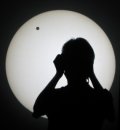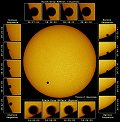|
Summary:
Every 120 years or so a dark spot glides across
the Sun. Small, inky-black, almost perfectly circular,
it's no ordinary sunspot. Not everyone can see
it, but some who do get the strangest feeling,
of standing, toes curled in the damp sand, on
the beach of a South Pacific isle.... Get the
full
story from Science@NASA.
Page
1 | Page
2 | Page
3 | Page
4 | Page
5 | Page
6 | Page
7
| This is Page 8
| Page 9
| Page 10
| Page 11
| Page 12
| Page 13
| Page 14
| Page 15
Unless otherwise stated, all images are copyrighted
by the photographers.
|
| |
Photographer,
Location |
Images |
Comments |
|

|
Bruno
Raeymaekers,
MIRA Public Observatory, Grimbergen, Belgium
Jun. 08 |
#1,
more |
The
photographer and Venus... At MIRA Public Observatory,
among many other telescopes, people could admire
this view of the Sun+Venus with our heliostat. It
projects an image of the sun (with a diameter of
140 cm) inside a lecture room. |
|

|
Cees
Bassa,
Beesd, the Netherlands
Jun. 08 |
#1,
more |
The
event was spectacular, though most images look the
same: the sun with a dot. Here is my try for something
special. This is a multi-exposure on a single piece
of film of the Venus transit. The first exposure,
taken without a solar filter, captured the silhouette
of the leaves and the blue background. After that
5 shots through a solar filter were taken to capture
the Sun and transiting Venus. [Photo details; Olympus
OM-1, Zuiko 300/4.5, Fuji Provia 100F; 10:04:40
UT, 1/250s @ F/32 w/o filter, then from 10:08:00
till 10:28:00 with 4 minute intervals 6x 1/125 s
@ F/8 w/ filter.] |
|

|
Anthony
Ayiomamitis,
Athens, Greece
Jun. 08 |
#1,
#2, #3,
more |
Thanks to pristine weather in
the eastern Mediterranean, these time series photos
represent a dedicated effort lasting nearly seven
hours of this truly wonderful event! The absence
of any dominant features on the solar disk, particularly
sunspots, provided for a view which was both breathtaking
and beyond any imagination possible. It begs a trip
to Australia in 2012 for a second dose of this magnificent
event! |
|

|
Rolando
Ligustri and Lucio Furlanetto,
Cast Observatory-Talmassons (UD) Italy
Jun. 08 |
#1,
more |
Date:
08 june 2004; time: 5:20-11:24 UT Site: Cast Observatory-Talmassons
(UD) Instruments: C11 with Digicam Nikon Coolpix
4300 |
|

|
Quanzhi
Ye,
Dalingshan,Guangzhou,China
Jun. 08 |
#1 |
2nd
edition, SkyWalker 127F6.45 & Canon PowerShot A70.
|
|

|
Guus
Besuijen,
Veere, The Netherlands
Jun. 08 |
#1,
more |
Coronado
Nearstar/Solarmax 60 H-alpha with Canon PS A60 (ISO
200, 1/20 sec, F4.8) revealed Venus next to a giant
solar flare when the transit had just started. |
|

|
Richard
Bosman,
Enschede Holland
Jun. 08 |
#1 |
I
took these high resolution images of the Venus Transit
to see if there is a "black drop" effect.
|
|

|
Jesús
Ojeda,
Saint Francis, Wisconsin, USA
Jun. 08 |
#1,
#2, #3 |
At
sunrise the haze was so heavy that no solar filter
was required for the first 15 minutes. Sony DSC-F707
digital camera attached to Meade 8' LX10 telescope.
|
|

|
Jack
Newton,
in Washington DC
Jun. 08 |
#1 |
6:45
am Eastern Daylight Time; through thick fog taken
from Washington, DC; Canon EOS Rebel digital camera
and Coronado MaxScope 90 Halpha. 4/10 sec. exposure.
Processed in MaxIm DL and Adobe PhotoShop |
more:
from
Mike Lynch of Frankfort, Kentucky; from
So Chu Wing of Hong Kong; from
Richard Schueller of Chelmsford, Massachusetts,
USA; from Darren
Osborne at CSIRO Headquarters, Canberra, Australia;
from Gilberto Klar
Renner of Tramandai, RS, Brazil; from
Furio Pieri of Prosecco- Trieste ITALY; from
Marcos Cue and Juan D. Rodriguez of Leon, Spain
(this is a projection of the Sun through a telescope
onto a white screen); from
Ivar Hamberg of Stockholm, Sweden; from
Nejc Ucman of Verdun, Novo mesto, Slovenia;
from Roland Nogal
of Hillsborough, New Jersey, USA;
|
back to spaceweather.com
|
|